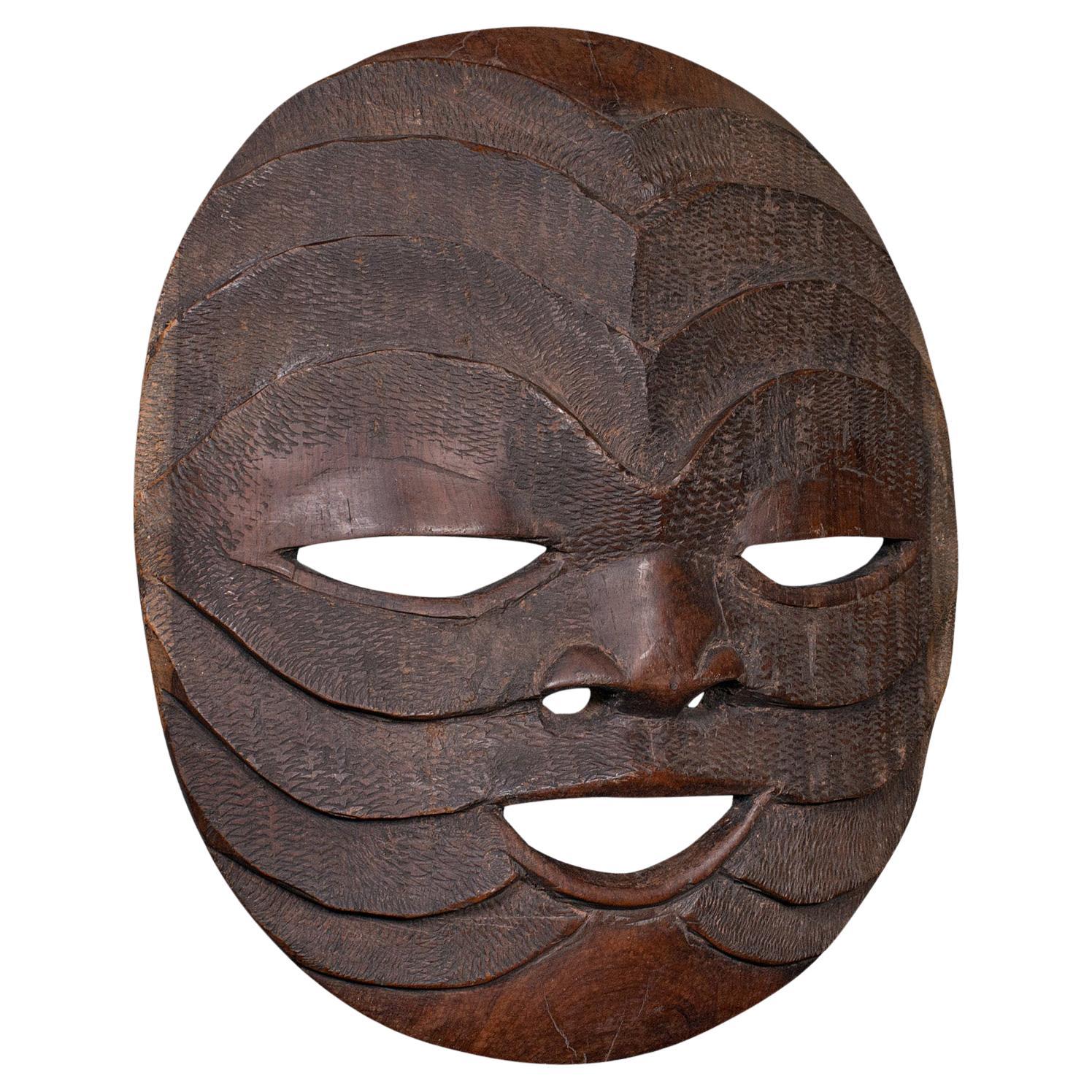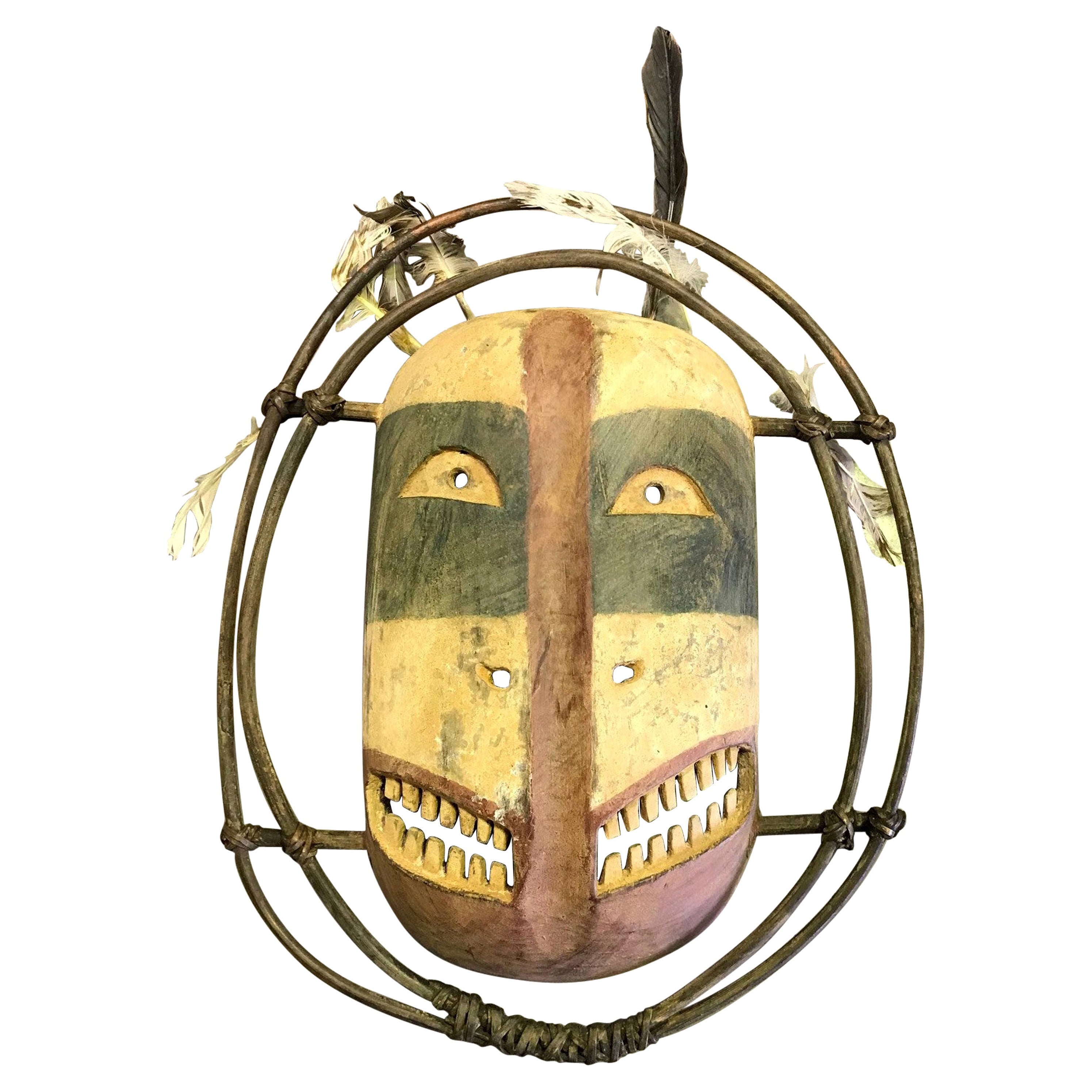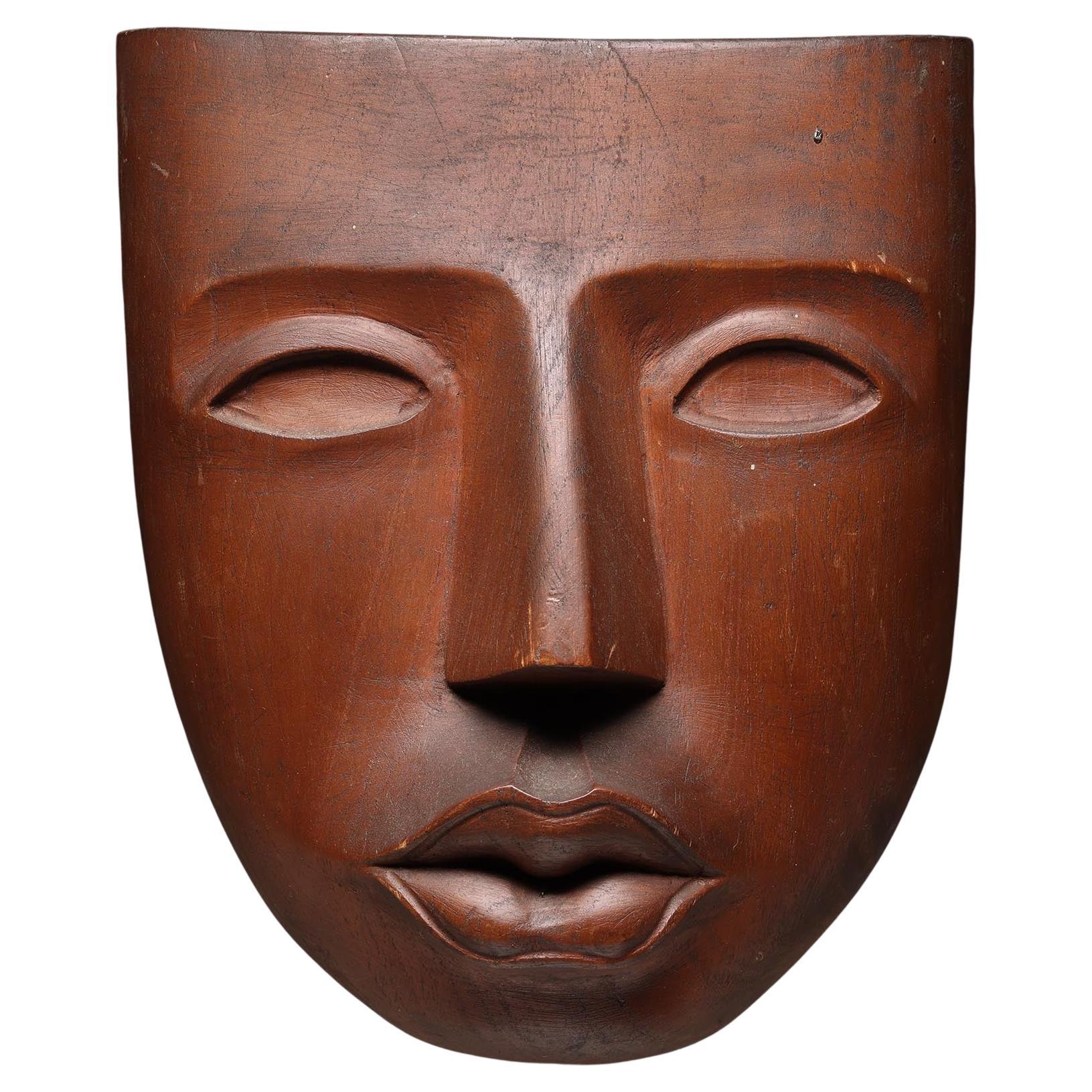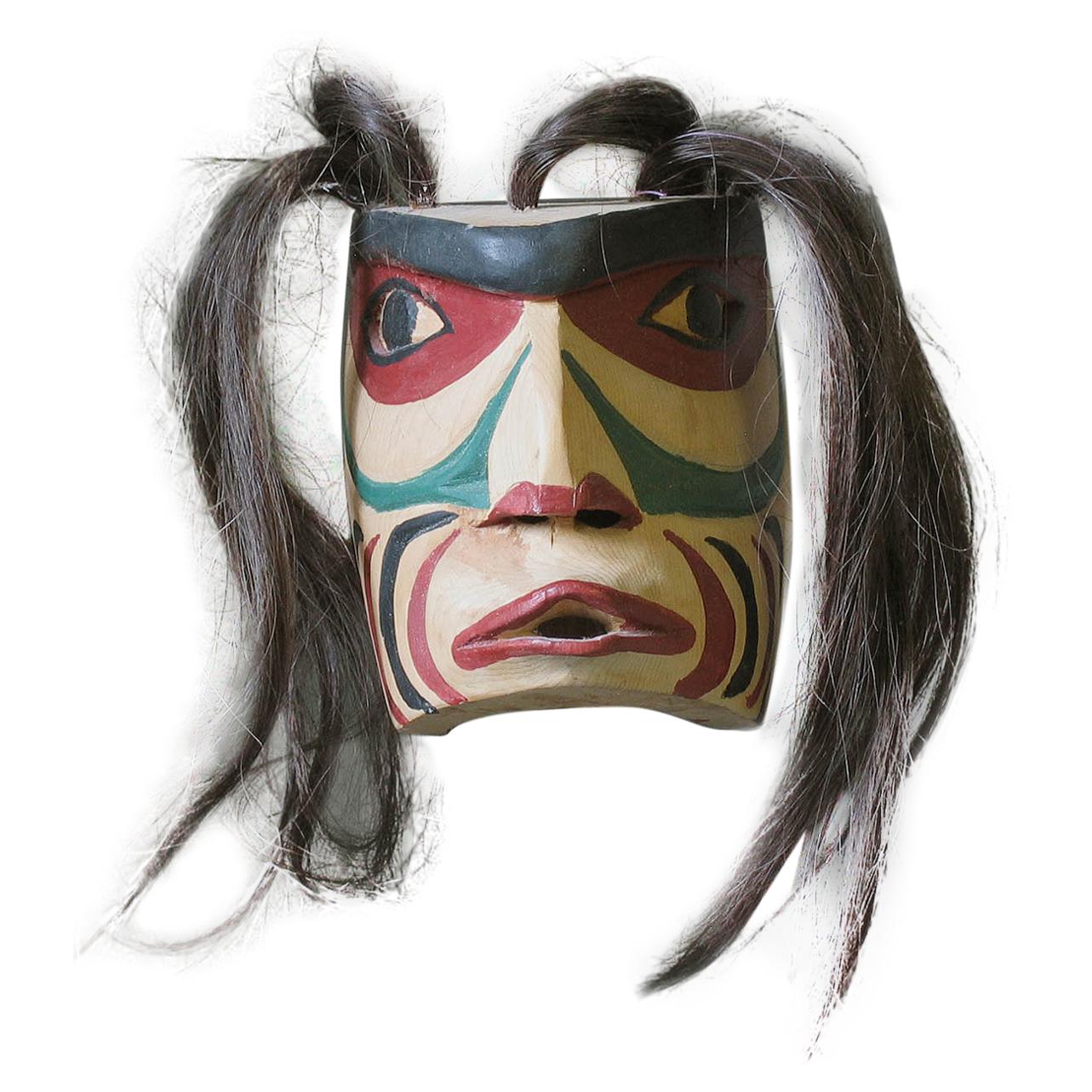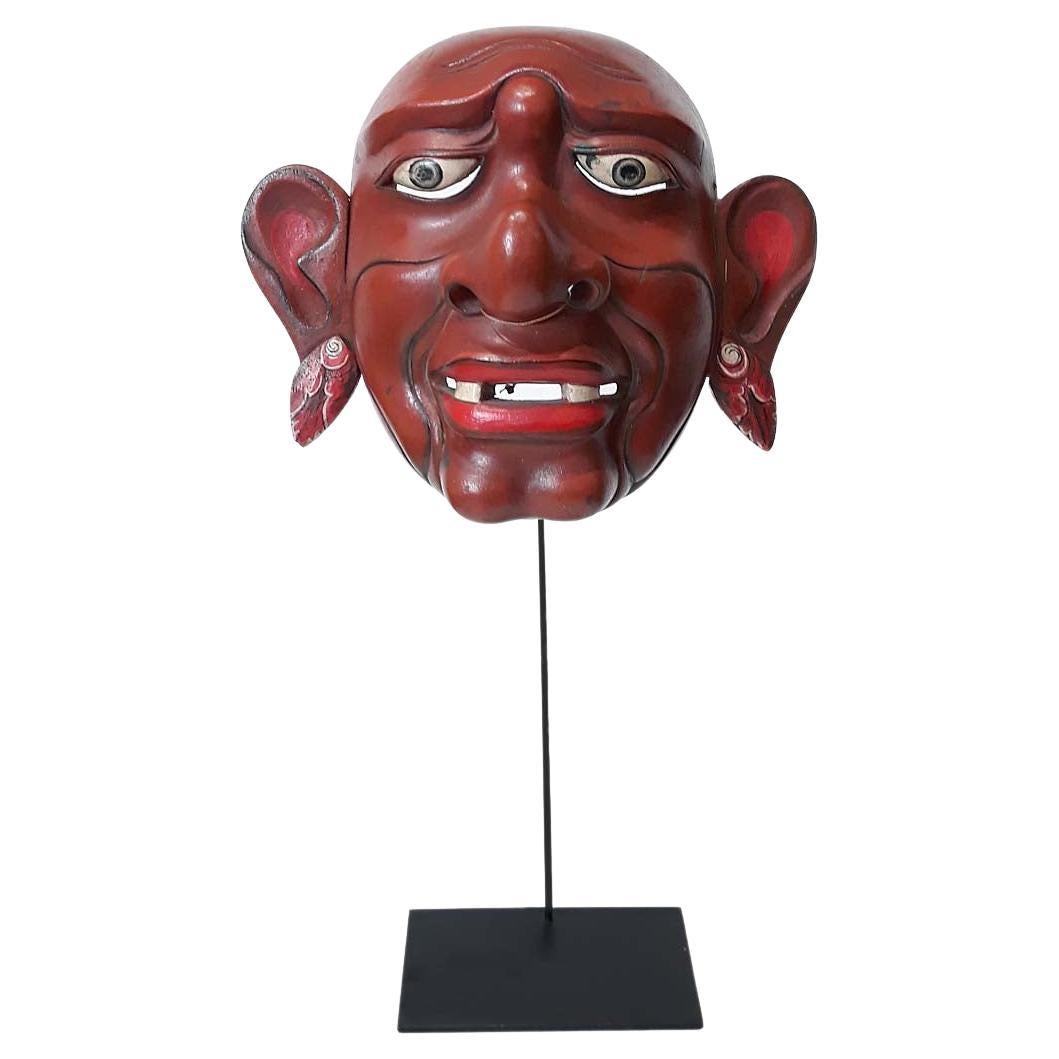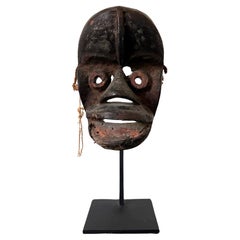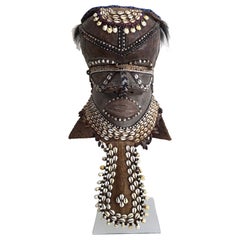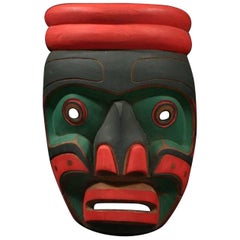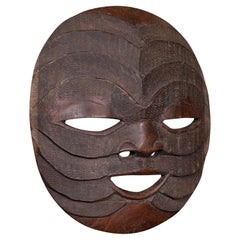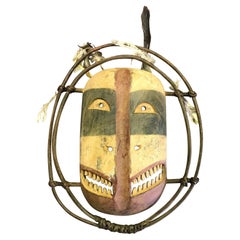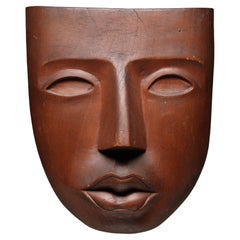Items Similar to Carved Tribal Mask from Pacific Northwest Coast by David Frankel
Want more images or videos?
Request additional images or videos from the seller
1 of 10
Carved Tribal Mask from Pacific Northwest Coast by David Frankel
$1,800
£1,353.46
€1,571.69
CA$2,513.66
A$2,787.84
CHF 1,464.04
MX$34,236.63
NOK 18,533.30
SEK 17,477.15
DKK 11,726.53
Shipping
Retrieving quote...The 1stDibs Promise:
Authenticity Guarantee,
Money-Back Guarantee,
24-Hour Cancellation
About the Item
A striking carved and painted mask in the tradition of the Native Indian tribes from Pacific Northwest Coast by David Frankel in 1994. The mask was carved from yellow cedar and painted with contrasting red and black colors in a geometrical pattern. The hair was made from natural fibers. The male mask features large round open eyes, a strong nose and a beguiling smiley. It may represent an ancestral spirit that bestow protection.
Signed and dated on the back as shown. From a Palm Beach, FL collection.
- Dimensions:Height: 14 in (35.56 cm)Width: 12 in (30.48 cm)Depth: 8.5 in (21.59 cm)
- Style:Native American (In the Style Of)
- Materials and Techniques:
- Place of Origin:
- Period:1990-1999
- Date of Manufacture:1994
- Condition:Wear consistent with age and use. Minor surface wear and patina.
- Seller Location:Atlanta, GA
- Reference Number:1stDibs: LU945022786652
About the Seller
4.9
Platinum Seller
Premium sellers with a 4.7+ rating and 24-hour response times
Established in 2006
1stDibs seller since 2010
562 sales on 1stDibs
Typical response time: <1 hour
- ShippingRetrieving quote...Shipping from: Atlanta, GA
- Return Policy
Authenticity Guarantee
In the unlikely event there’s an issue with an item’s authenticity, contact us within 1 year for a full refund. DetailsMoney-Back Guarantee
If your item is not as described, is damaged in transit, or does not arrive, contact us within 7 days for a full refund. Details24-Hour Cancellation
You have a 24-hour grace period in which to reconsider your purchase, with no questions asked.Vetted Professional Sellers
Our world-class sellers must adhere to strict standards for service and quality, maintaining the integrity of our listings.Price-Match Guarantee
If you find that a seller listed the same item for a lower price elsewhere, we’ll match it.Trusted Global Delivery
Our best-in-class carrier network provides specialized shipping options worldwide, including custom delivery.More From This Seller
View AllGuere Mask from Cote d'Ivoire Africa with Sotheby's Sticker
Located in Atlanta, GA
A Guere wood mask with paint and fiber remnant from We people displayed on a metal stand. The We people (also known as the Krahn or Guere) are an indigenous African people that inhabit areas in nowadays eastern Liberia and western Côte d'Ivoire. Their material culture shares many aspects with the neighboring Dan tribe. Like the Dans, the We use a wide variety of masquerades, which hold important regulatory position within their small, egalitarian communities. Masks are owned by families and used by individual lineage members in contexts of social control, ritual ceremony and entertainment. This type of Guere mask, however, has a distinct fearsome character. The ferocious design with jagged facial expression, bulging tubular eyes are intended for use in mediations between community members, as visual aids during moral lessons, as well as forms of entertainment. By portraying the more frightening nature of the animal, the mask is viewed as powerful and may have been used as part of social control methods prior to the introduction of Western law systems during the colonial period.
The mask on offer, based on our examination, appears to be an original one that was used natively instead of reproduction made for the tourist market. The surface presents apparently genuine patina consistent with use. The red paint that highlights the eyes and gapping mouth also appear original. There are small losses flanking the nose ridge by the eyes, extensive surface accretion, remain of some fiber tassels. The back of the mask reveals chisel marks from hand tools and importantly, stain marks that were likely from repetitive contacts from the nose of the wearer.
The mask is 9" in height, and it retains an old Sotheby’s catalog...
Category
20th Century Ivorian Tribal Tribal Art
Materials
Wood
Lega Bwami Society Mask on Display Stand with Provenance
Located in Atlanta, GA
On offer is a Lega Bwami society wooden mask from the Democratic Republic of Congo. It was likely from the first half of the 20th century and an authentic in-field piece. The mask di...
Category
Mid-20th Century Congolese Tribal Tribal Art
Materials
Wood
Helmet Crest Ngoin Mask from Cameroon Africa
Located in Atlanta, GA
This Helmet Crest mask is categorized as a “Babanki” style Ngoin mask from Northwestern provinces of Cameroon circa first half of 20th century. In part of highland area called “Camer...
Category
20th Century Cameroonian Tribal Tribal Art
Materials
Wood
African Kuba Helmet Mask on Stand
Located in Atlanta, GA
A Helmet Mask known as Bwoon from the Kuba Tribe in the Kasai region of Democratic Republic of the Congo, Central Africa circa mid-20th century. The carved wood mask was decorated with copper plates on the face, and lavished embellished with trade beads, raffia cloth with cowrie shells and hanging seed pods, fur possibly from monkey. The surface and the interior both display good patina indicates a native use (contact rubbing) and age.
Bwoom is one of three types of royal Kuba masks...
Category
20th Century Congolese Tribal Masks
Materials
Copper
Japanese Wood Bugaku Mask of Korobase Edo Period
Located in Atlanta, GA
A striking Japanese carved wood mask with polychrome paint and lacquer surface. This rare mask is dated to the Edo period (first half of 19th century and possibly earlier). The mask ...
Category
Antique 19th Century Japanese Japonisme Sculptures and Carvings
Materials
Wood, Lacquer, Paint
Tall African Ibibio Head Mask with Polychrome Nigeria Provenance
Located in Atlanta, GA
A tall Ibibio wood mask from Nigeria, Africa, circa 20th century. The head mask was carved in with a frontal face with pierced eyes and a gapping mouth. On his head, a stylized hat ...
Category
20th Century Nigerian Tribal Figurative Sculptures
Materials
Rattan, Wood
You May Also Like
20th Century Mask God of the Undersea World by Stanley Clifford Hunt
By Stan Hunt
Located in Point Richmond, CA
20th Century Mask God of the Undersea World by Stanley Clifford Hunt Signed
A striking, graphic mask in the immediately identifiable North West Coast tradition.. The mask is expert...
Category
Vintage 1970s Canadian Other Masks
Materials
Cedar, Paint
Vintage Display Mask, African, Ironwood, Carved, Ceremonial, Tribal, Decorative
Located in Hele, Devon, GB
This is a vintage display mask. An African, carved ironwood ceremonial tribal mask, dating to the late 20th century.
Fascinating ridged carvings accentuate this distinctive mask
Di...
Category
Late 20th Century Malawian Tribal Masks
Materials
Wood
Yupik Yup'ik Native American Alaska Carved Polychrome Wood Anthropomorphic Mask
Located in Studio City, CA
A fantastic and somewhat grotesquely strange mask by the Yup'ik (Yupik) aboriginal, indigenous people of South-Western & South Central Alaska. The Yup'ik people, who are related to t...
Category
20th Century American Masks
Materials
Natural Fiber, Wood, Paint
Finely carved Mid Century North West Coast Carved Wood Mask Expressive Face
Located in Point Richmond, CA
Very finely carved face mask, probably from the North West Coast of the US or Canada. Created mid 20th century or earlier, the artist is unfortunately unknown. Carved light wood, p...
Category
Mid-20th Century Canadian Tribal Tribal Art
Materials
Wood
Small Warrior Spirit Mask, Northwest Coast by Charlie Mickey, Nootka Nation
By Charlie Mickey
Located in Ottawa, Ontario
A small warrior spirit mask
Northwest Coast
Carved and polychrome decorated mask with horse hair,
Hand carved by Charlie Mickey (1910-1988), Hesquiah...
Category
Mid-20th Century Canadian Native American Tribal Art
Materials
Wood
Balinese Wood Mask, Mid-20th Century
Located in New York, NY
A vintage theater mask from Bali, Indonesia, circa 1975-1980.
Polychromed hand-carved teak, mounted on a black metal stand.
This type of mask is used at Indonesian Topeng or Mas...
Category
Vintage 1970s Indonesian Tribal Masks
Materials
Teak
More Ways To Browse
Pacific Northwest Furniture
Carved American Indian
Native American Carved Wood
Native American Northwest
Mask Indian
Northwest Coast Native Art
Northwest Coast Native American
Northwest Coast Mask
Native American Pacific Northwest Carved
Pacific Northwest Mask
Pacific Northwest Tribal Mask
Antique Wood Mask
Wooden Carved Masks
Ceremonial Mask
Vintage Wood Masks
Masquerade Mask
Indonesia Mask
Mask Wood Indonesian

